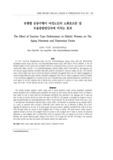

PARTNER
검증된 파트너 제휴사 자료
유형별 운동수행이 여성노인의 노화호르몬 및 우울증관련인자에 미치는 효과
방대한 850만건의 자료 중 주제별로 만들수 있는 최적의 산출물을 해피 캠퍼스에서 체험 하세요 전문가의 지식과 인사이트를 활용하여 쉽고 폭넓게 이해하고 적용할수 있는 기회를 놓치지 마세요
14 페이지
최초등록일 2015.03.25
최종저작일
2013.01

-
 * 본 문서는 배포용으로 복사 및 편집이 불가합니다.
* 본 문서는 배포용으로 복사 및 편집이 불가합니다.
미리보기
서지정보
· 발행기관 : 한국웰니스학회
· 수록지 정보 : 한국웰니스학회지 / 8권 / 4호
· 저자명 : 김찬회, 이중원, 한상인
목차
Ⅰ. 서 론
Ⅱ. 연구방법
Ⅲ. 연구결과
Ⅳ. 논 의
참고문헌초록
본 연구는 여성노인을 통제집단(Control Group; CG) 8명, 수중운동집단(Aquatic Exercise Group; AEG) 8명, 협응력운동집단(Coordination Exercise Group; CEG) 8명, 유산소운동집단(Treadmill Exercise Group; TEG) 8명으로 무선으로 배정하여, 주 3회, 1회60-70분의 방법으로 각각의 운동을 12주간 실시하였다. 혈액검사 및 우울증검사를 운동전, 운동 8주후, 운동 12주후에 각각 실시하여,노화호르몬(E2, DHEAs, GH, IGF-Ⅰ) 및 우울증관련인자(Serotonin, GDS-K)의 변화를 규명하기 위하여 SPSS Ver. 18.0 Program을 이용하여 Two-way repeated ANOVA를 실시하였다. E2(F=4.700, p<.01)에서 상호작용효과가 나타났으나, DHEAs, GH, IGF-Ⅰ에서 상호작용효과가 나타나지 않았다. E2의 집단 내 차이에 있어 CEG에서 운동전(5.33±1.59 pg/ml)에 비하여 운동 12주 후(10.27±5.48pg/ml)에 유의하게 증가하였으며(F=4.270, p<.05), TEG에서 운동전(5.23±1.25pg/ml)에 비하여 운동 8주 후(9.61±4.13pg.ml)에 유의하게 증가하였다가 운동 12주후(6.43±1.89pg/ml)에 다시 유의하게 감소한 것으로 나타났다(F=5.523, p<.05). GDS-K와 Serotonin에서 상호작용효과가 나타나지 않았다. 본 연구에서 수행되어진 CEG 및 TEG에서 E2의 긍정적인 효과를 볼 수 있었으며, 즉, 유산소 형태의 운동을 통하여노화로 인한 신체적?정서적인 불안감을 개선시킬 수 있는 가능성이 제시되었다고 사료된다.영어초록
This research randomly assigned 8 elderly women each in control group(CG), aquatic exercise group(AEG), coordinationexercise group(CEG) and in treadmill exercise group(TEG) and carried out each exercise with the duration of 60 to 70 minutes 3times weekly for total 12 weeks. Blood test and depression test(GDS-K) were performed in the beginning, after 8 weeks andafter 12 weeks of exercise. And the test results were used in the SPSS Ver. 18.0 program to investigate the changes in levels ofaging hormones(Estradiol; E2, Dehydroepiandrosterone; DHEAs, Growth Hormone; GH, and Insulin-like Growth Factor type 1; IGF-Ⅰ) and depression factors(Geriatric Depression Scale in Korea; GDS-K, and Serotonin) by performing two-way repeated ANOVA.As a result, an interaction effect occurred in E2(F=4.700, p<.01), wherein there was no difference in DHEAs, GH or IGF-I.Regarding the difference in the level of E2 within groups, CEG group showed a significant increase(F=4.270, p<.05) in E2 from5.33±1.59 pg/ml before the exercise to 10.27±5.48pg/ml after 12 weeks of exercise. TEG group however, initially showed asignificant increase in E2 from 5.23±1.25pg/ml before the exercise to 9.61±4.13pg.ml after 8 weeks of exercise, but decreasedsignificantly to 6.43±1.89pg/ml after 12 weeks(F=5.523, p<.05). No interaction effect was detected in the levels of GDS-K andSerotonin. This research observed positive changes in the levels of E2 in groups CEG and TEG. This brings to the conclusionthat aerobic exercise may help ease physical and emotional anxieties from aging process.참고자료
· 없음태그
-
자료후기
-
자주묻는질문의 답변을 확인해 주세요

꼭 알아주세요
-
본 학술논문은 (주)학지사와 각 학회간에 저작권계약이 체결된 것으로 AgentSoft가 제공 하고 있습니다.
본 저작물을 불법적으로 이용시는 법적인 제재가 가해질 수 있습니다. -
해피캠퍼스는 구매자와 판매자 모두가 만족하는 서비스가 되도록 노력하고 있으며, 아래의 4가지 자료환불 조건을 꼭 확인해주시기 바랍니다.
파일오류 중복자료 저작권 없음 설명과 실제 내용 불일치 파일의 다운로드가 제대로 되지 않거나 파일형식에 맞는 프로그램으로 정상 작동하지 않는 경우 다른 자료와 70% 이상 내용이 일치하는 경우 (중복임을 확인할 수 있는 근거 필요함) 인터넷의 다른 사이트, 연구기관, 학교, 서적 등의 자료를 도용한 경우 자료의 설명과 실제 자료의 내용이 일치하지 않는 경우
“한국웰니스학회지”의 다른 논문도 확인해 보세요!
-
Associations of Lifestyle Factors with Cancer Mortality and Life Expec.. 8 페이지
본 연구의 목적은 생활습관 요인 인자들과 (흡연, 비운동, 복부비만 등) 현대사회에서 가장 흔히 발생하는 10대 암 사망률과의연관관계를 조사 하는데 있었다. 생활습관 요인 인자들은 0, 1, 2, 3 종류의 통합된 생활습관 형태로 분류하였다. 건강한 남자들을(N=24,723; 연령, 20-80세), 평균적으로 14.5년 동안 추적 조사한 결과, 244명이 .. -
초등학생의 체육수업이 BDNF, IGF-1 및 건강관련체력에 미치는 영향 10 페이지
이 연구의 목적은 뇌 발달시기인 초등학생을 대상으로 학교체육수업이 혈중 BDNF와 IGF-1 및 건강관련 체력에 미치는 영향을알아보기 위해 실시되었다. 연구대상은 경기도에 소재한 G 초등학교 학생으로 평소 병력이 없는 학생 30명(12세)으로 선정하였다.본 연구에서의 체육수업모형으로 체조활동의 뜀틀종목을 선정하였으며, 실험기간은 총 8주이고, 주 3회로 실.. -
유도선수의 웨이트트레이닝 시 각 관절별 적정 중량부하에 관한 연구 12 페이지
본 연구는 대학유도선수들을 대상으로 웨이트트레이닝 시 중량의 부하를 1RM의 50%, 65%, 80%로 각각 설정하여 각 관절별근력과 근지구력을 효과적으로 증가시킬 수 있는 적절한 부하량을 알아보기 위함이다. 대상자는 3년 이상 선수생활 및 광역시?도대회 4강 이내에 입상한 경험이 있는 유도선수 22명으로 하였다. 자료처리는 SPSS 18.0 program.. -
운동, 고주파기기와 열량제한의 복합비만관리 프로그램이 비만여성의 혈청지질과 혈청호르몬에 미치는 영향 14 페이지
본 연구는 8주 동안의 비만관리 프로그램이 혈청지질과 혈청 호르몬 농도에 미치는 영향을 알아보고자 하였으며, 이 연구 결과는 다양한 복합관리 프로그램을 개발하는데 도움이 되기를 기대한다. 비만 연구 대상자는 운동군 13명, 고주파군 18명, 열량제한군 12명, 복합관리군 13명으로 하였다. 체중과 BMI는 복합관리군과 열량제한군에서 감소율이 크게 나타났으며.. -
운동 후 스포츠 마사지 유형이 코티졸 및 유리지방산과 젖산 농도에 미치는 영향 9 페이지
본 연구는 최대 운동 후 회복기에 스포츠 마사지 유형을 적용하여 혈중 코티졸 농도, FFA(지방산)과 혈중 젖산 농도을 측정하여 일반인과 운동선수들에게 휴식 방법의 개선과 경기력 향상에 에 도움을 주고 현장에서 보다 빠른 피로회복에 도움을 주고자한다. 이 연구는 남자 대학생 10명을 대상으로 3집단으로 나누어 반복 측정하였다. 결과 처리는 SPSS 18.0..
문서 초안을 생성해주는 EasyAI

